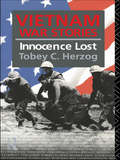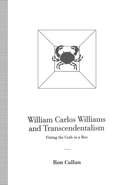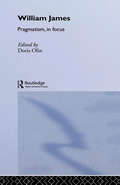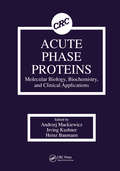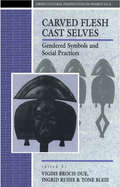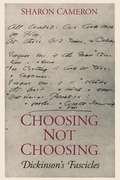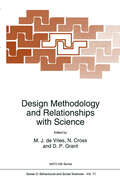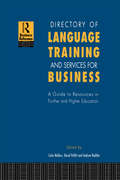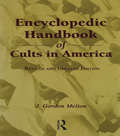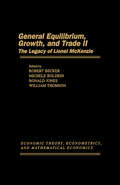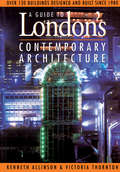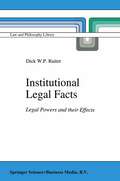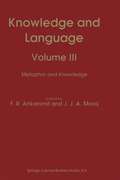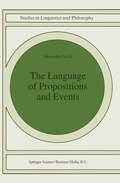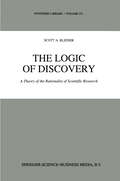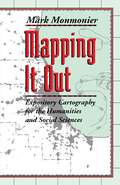- Table View
- List View
Vietnam War Stories: Innocence Lost
by Tobey C. HerzogThe Gulf War and its aftermath have testified once again to the significance placed on the meanings and images of Vietnam by US media and culture. Almost two decades after the end of hostilities, the Vietnam War remains a dominant moral, political and military touchstone in American cultural consciousness. Vietnam War Stories provides a comprehensi
William Carlos Williams and Transcendentalism: Fitting the Crab in a Box
by Ron CallanThis book examines the achievements of William Carlos Williams in the context of the transcendentalism of Ralph Waldo Emerson, Henry David Thorgau and Walt Whitman. The author develops a narrative of sensibilities to enrich the understanding of transcendentalism.
William James Pragmatism in Focus
by Doris OlinThis book presents William James's Pragmatism together with critical commentary and focuses on the theories of meaning and truth central to Pragmatism. It includes several articles three of which were roughly contemporaneous with the publication of Pragmatism.
William James Pragmatism in Focus
by Doris OlinThis book presents William James's Pragmatism together with critical commentary and focuses on the theories of meaning and truth central to Pragmatism. It includes several articles three of which were roughly contemporaneous with the publication of Pragmatism.
Acute Phase Proteins Molecular Biology, Biochemistry, and Clinical Applications
by Andrzej Mackiewicz Irving Kushner Heinz BaumannAcute Phase Proteins covers all major aspects of acute phase proteins (APP) starting with molecular mechanisms regulating their synthesis and ending with their functional significance. The book features 36 chapters addressing such topics as acute phase response and the APP; major APP and their structure and functions; regulation of APP synthesis, the cytokines and hormones implicated in these processes, and molecular mechanisms involved; signal transduction of cytokines in hepatocytes and posttranscriptional processes; and quantitative and qualitative evaluation of APP in clinical practice. The book will be an important reference for immunologists, molecular biologists, cellular biologists, biochemists, and clinical chemists.
Acute Phase Proteins Molecular Biology, Biochemistry, and Clinical Applications
by Andrzej Mackiewicz Irving Kushner Heinz BaumannAcute Phase Proteins covers all major aspects of acute phase proteins (APP) starting with molecular mechanisms regulating their synthesis and ending with their functional significance. The book features 36 chapters addressing such topics as acute phase response and the APP; major APP and their structure and functions; regulation of APP synthesis, the cytokines and hormones implicated in these processes, and molecular mechanisms involved; signal transduction of cytokines in hepatocytes and posttranscriptional processes; and quantitative and qualitative evaluation of APP in clinical practice. The book will be an important reference for immunologists, molecular biologists, cellular biologists, biochemists, and clinical chemists.
Carved Flesh / Cast Selves: Gendered Symbols and Social Practices
by Vigdis Broch-DueAll the papers in this volume deal with the central theme of gender. The social contexts they examine range widely from Melanesia and Southeast Asia to Africa, Europe and America; yet in each case of these very diverse cases the concern is to analyse the ways in which gender is constructed.
Carved Flesh / Cast Selves: Gendered Symbols and Social Practices
by Tone Bleie Vigdis Broch-Due I. RudieAll the papers in this volume deal with the central theme of gender. The social contexts they examine range widely from Melanesia and Southeast Asia to Africa, Europe and America; yet in each case of these very diverse cases the concern is to analyse the ways in which gender is constructed.
Choosing Not Choosing: Dickinson's Fascicles
by Sharon CameronAlthough Emily Dickinson copied and bound her poems into manuscript notebooks, in the century since her death her poems have been read as single lyrics with little or no regard for the context she created for them in her fascicles. Choosing Not Choosing is the first book-length consideration of the poems in their manuscript context. Sharon Cameron demonstrates that to read the poems with attention to their placement in the fascicles is to observe scenes and subjects unfolding between and among poems rather than to think of them as isolated riddles, enigmatic in both syntax and reference. Thus Choosing Not Choosing illustrates that the contextual sense of Dickinson is not the canonical sense of Dickinson. Considering the poems in the context of the fascicles, Cameron argues that an essential refusal of choice pervades all aspects of Dickinson's poetry. Because Dickinson never chose whether she wanted her poems read as single lyrics or in sequence (nor is it clear where any fascicle text ends, or even how, in context, a poem is bounded), "not choosing" is a textual issue; it is also a formal issue because Dickinson refused to chose among poetic variants; it is a thematic issue; and, finally, it is a philosophical one, since what is produced by "not choosing" is a radical indifference to difference. Extending the readings of Dickinson offered in her earlier book Lyric Time, Cameron continues to enlarge our understanding of the work of this singular American poet.
Design Methodology and Relationships with Science (NATO Science Series D: #71)
by D. P. Grant N. Cross M. J. VriesMany business corporations are faced with the challenge of bringing together quite different types of knowledge in design processes: knowledge of different disciplines in the natural and engineering sciences, knowledge of markets and market trends, knowledge of political and juridical affairs. This also means a challenge for design methodology as the academic discipline that studies design processes and methods. The aim of the NATO ARW of which this book is the report was to bring together colleagues from different academic fields to discuss this increasing multidisciplinarity in the relationship between design and sciences. This multidisciplinarity made the conference a special event. At a certain moment one of the participants exclaimed: "This is not a traditional design methodology conference!" Throughout the conference it was evident that there was a need to develop a common language and understanding to enable the exchange of different perspectives on design and its relationship with science. The contributions that have been included in this book show these different perspectives: the philosophical, the historical, the engineering perspective and the practical designer's experience.
Directory of Language Training and Services for Business: A Guide to Resources in Further and Higher Education
by Colin Mellors David Pollitt Andrew RadtkeLanguage acquisition and training is a key concern for businesses of all types and sizes. This Directory is an invaluable resource for anyone needing information on language training for business. The Directory also provides information on services for business such as translation and interpreting. Ordered A-Z by institution, the Directory will enable speedy identification of providers from a bank of over 400 institutional and other contacts across the UK.
Directory of Language Training and Services for Business: A Guide to Resources in Further and Higher Education
by Colin Mellors David Pollitt Andrew RadtkeLanguage acquisition and training is a key concern for businesses of all types and sizes. This Directory is an invaluable resource for anyone needing information on language training for business. The Directory also provides information on services for business such as translation and interpreting. Ordered A-Z by institution, the Directory will enable speedy identification of providers from a bank of over 400 institutional and other contacts across the UK.
Encyclopedic Handbook of Cults in America (Religious Information Systems)
by J. Gordon MeltonFirst Published in 1993. Routledge is an imprint of Taylor & Francis, an informa company.
Encyclopedic Handbook of Cults in America (Religious Information Systems #7)
by J. Gordon MeltonFirst Published in 1993. Routledge is an imprint of Taylor & Francis, an informa company.
The Epic History of Biology
by Anthony SerafiniThe search for our elusive human origins and an understanding of the mysteries of the human body have challenged the most inquisitive and imaginative thinkers from Egyptian times through the twentieth century. In The Epic History of Biology, Anthony Serafini - a distinguished philosopher and historian of science - regales the reader with the triumphs and failures of the geniuses of the life sciences. The subtleties of the animal kingdom - anatomy, zoology, and reproduction - along with the complexities of the plant kingdom, have fascinated humanity as far back as 5000 years ago. Astounding ancient knowledge of the arcane curing powers of herbs as well as early experimentation with different chemical combinations for such purposes as mummification led to today's biological technology. Innovative pioneers such as Aristotle, Galen, Hippocrates, and Vesalius challenged the limits of knowledge and single-mindedly pursued their work, often in the face of blind superstition. In superb, lyrical prose Serafini recreates the ideas and theories of these revolutionaries from ancient times through today, against the backdrop of the dogma and prejudices of their time. He explores the inspired revelations that gave birth to such discoveries as the controversial theory of evolution, the humble origins of genetics, the fantastic predictions of quantum mechanics, and the infinite promise of computer technology. Even today the biological sciences are undergoing rapid and kaleidoscopic changes. Every new insight gives rise to a myriad of new ethical questions and responsibilities. The Epic History of Biology confronts these issues head on and predicts the wondrous new directions biology will follow.
General Equilibrium, Growth, and Trade II: The Legacy of Lionel McKenzie
by Robert Becker Michele Boldrin Ronald JonesGeneral Equilibrium, Growth, and Trade, Volume II: The Legacy of Lionel McKenzie presents the impact of Lionel McKenzie's contributions on modern economics. This book discusses McKenzie's researches that are relevant in applied economic fields, including general equilibrium, optimal growth, and international trade.Organized into three parts encompassing 24 chapters, this volume begins with an overview of the existence of competitive equilibrium in an economy with a finite number of agents and commodities. This text then presents two analyses that are basically responses to criticism of the development of real indeterminacy. Other chapters consider McKenzie's assumption of irreducibility, which plays a significant role in showing how compensated equilibria will be uncompensated equilibria because agents have cheaper net trade vectors in their feasible sets. This book discusses as well some properties of competitive equilibria for dynamic exchange economies with an infinite horizon and incomplete financial markets.This book is a valuable resource for economists and economic theorists.
Guide to London's Contemporary Architecture
by Victoria Thornton Kenneth AllinsonGuide to London's Contemporary Architecture provides a guide to the wealth of architecture completed in London. The book first offers information on the buildings located in the City of London and the Docklands. These include the Broadgate Complex, Alban Gate, Bracken House, Whitechapel Art Gallery, Queen Street offices, Girozentrale Vienna, Minster Court, Billingsgate Securities Market, Canary Wharf, Financial Times Printing Works, Isle of Dogs Neighborhood Center, Reuters Technical Services Centre, and the David Mellor building. The publication examines the structures found in the East End, West End, and north London. Discussions focus on Sainsbury Wing, National Gallery, Sackler Gallery, Queen Elizabeth II Conference Center, Richmond House, Clore Gallery, Lauriston Studios, Leyton Fire Station, Lisson/Bell Street galleries, Lisson Grove offices and flats, Sainsbury supermarket and housing, Crowndale Centre, Nightingale house, and the Bisterne Avenue apartments. The text takes a look at the edifices located in west London, including Richmond Riverside, Sterling Hilton Hotel, Thames Wharf Studios, St Mary's Church, Barnes, Metropolis Studios, and the Fowler/Jestico house.The publication is a dependable reference for architects and design engineers interested in the architecture of London.
Institutional Legal Facts: Legal Powers and their Effects (Law and Philosophy Library #18)
by D.W. RuiterLaw is traditionally conceived as consisting of norms of conduct and power-conferring norms. This conception, however, is unable to account for a variety of elements of modern legal systems that differ significantly from the classical notions. This book concerns the problem of which results of human activity can obtain legal validity. The author makes use of recent findings in speech act theory, especially John R. Searle and Daniel Vanderveken's illocutionary logic. He sets out a theory of legal norms conceived as institutional legal facts resulting from performances of speech acts specified in power-conferring norms. The theory provides a classification of acts-in-the-law and of legal norms resulting from performances of these. Finally, the transition is made from institutional legal facts to legal institutions. The book is a contribution to the institutional theory of law as developed by N. MacCormick and O. Weinberger.
Knowledge and Language: Volume III Metaphor and Knowledge
by F. R. Ankersmit J. J. A. MooijMetaphor lies at the heart of the contemporary debate in aesthetics, semantics and the philosophy of science. It is generally recognised now that metaphor is not an obfuscation of the truth (as so many philosophers since Plato have argued); on the contrary, it is essential that we consider metaphor if we strive for an optimal understanding of how truth is gained both in science and in our everyday dealings with reality. Hence, metaphor is not of interest only for the literary theorists, but for all those who wish to understand science and how to grasp the structure of our social world. This volume presents eleven essays on the role of metaphor in philosophy, poetry, semiotics, art, literary criticism, economics, medical science and in political theory. Through the use of metaphor, the contributors provide a unique and exciting picture of these disciplines.
The Language of Propositions and Events: Issues in the Syntax and the Semantics of Nominalization (Studies in Linguistics and Philosophy #51)
by Alessandro ZucchiAt a superficial examination, English has different types of nominals with similar meaning and distribution: (1)a. John's performance ofthe song b. J ohn' s performing of the song c. John's performing the song d. the fact that John performs the song These nominals are also perceived by English speakers to be related to the same sentential construction: (2) John performs the song A more accurate inspection reveals, however, that the nominals in (1) differ both in their distribution and in the range of interpretations they allow. An adequate theory of nominalization should explicate rigorously how nominals of the types in (1) are related to sentential construction (2), and should also account for their distributional differences and meaning differences. The task of this book is to develop such a theory. I defend two main theses. The first is that, in order to provide an adequate semantics for the nominals in (1), one needs to distinguish among three types of entities in the domain of discourse (in addition to the type of ordinary individuals): events, propositions, and states xiii XIV PREFACE of affairs. I argue that the nominals in (1) differ in their ability to denote entities of these types and that predicates differ in their ability to select for them.
The Logic of Discovery: A Theory of the Rationality of Scientific Research (Synthese Library #231)
by S. KleinerScientific research is viewed as a deliberate activity and the logic of discovery consists of strategies and arguments whereby the best objectives (questions) and optimal means for achieving these objectives (heuristics) are chosen. This book includes a discussion and some proposals regarding the way the logic of questions can be applied to understanding scientific research and draws upon work in artificial intelligence in a discussion of heuristics and methods for appraising heuristics (metaheuristics). It also includes a discussion of a third source for scientific objectives and heuristics; episodes and examplars from the history of science and the history of philosophy. This book is written to be accessible to advanced students in philosophy and to the scientific community. It is of interest to philosophers of science, philosophers of biology, historians of physics, and historians of biology.
Mapping It Out: Expository Cartography for the Humanities and Social Sciences (Chicago Guides to Writing, Editing, and Publishing)
by Mark MonmonierWriters know only too well how long it can take—and how awkward it can be—to describe spatial relationships with words alone. And while a map might not always be worth a thousand words, a good one can help writers communicate an argument or explanation clearly, succinctly, and effectively. In his acclaimed How to Lie with Maps, Mark Monmonier showed how maps can distort facts. In Mapping it Out: Expository Cartography for the Humanities and Social Sciences, he shows authors and scholars how they can use expository cartography—the visual, two-dimensional organization of information—to heighten the impact of their books and articles. This concise, practical book is an introduction to the fundamental principles of graphic logic and design, from the basics of scale to the complex mapping of movement or change. Monmonier helps writers and researchers decide when maps are most useful and what formats work best in a wide range of subject areas, from literary criticism to sociology. He demonstrates, for example, various techniques for representing changes and patterns; different typefaces and how they can either clarify or confuse information; and the effectiveness of less traditional map forms, such as visibility base maps, frame-rectangle symbols, and complementary scatterplot designs for conveying complex spatial relationships. There is also a wealth of practical information on map compilation, cartobibliographies, copyright and permissions, facsimile reproduction, and the evaluation of source materials. Appendixes discuss the benefits and limitations of electronic graphics and pen-and-ink drafting, and how to work with a cartographic illustrator. Clearly written, and filled with real-world examples, Mapping it Out demystifies mapmaking for anyone writing in the humanities and social sciences. "A useful guide to a subject most people probably take too much for granted. It shows how map makers translate abstract data into eye-catching cartograms, as they are called. It combats cartographic illiteracy. It fights cartophobia. It may even teach you to find your way."—Christopher Lehmann-Haupt, The New York Times
Mapping It Out: Expository Cartography for the Humanities and Social Sciences (Chicago Guides to Writing, Editing, and Publishing)
by Mark MonmonierWriters know only too well how long it can take—and how awkward it can be—to describe spatial relationships with words alone. And while a map might not always be worth a thousand words, a good one can help writers communicate an argument or explanation clearly, succinctly, and effectively. In his acclaimed How to Lie with Maps, Mark Monmonier showed how maps can distort facts. In Mapping it Out: Expository Cartography for the Humanities and Social Sciences, he shows authors and scholars how they can use expository cartography—the visual, two-dimensional organization of information—to heighten the impact of their books and articles. This concise, practical book is an introduction to the fundamental principles of graphic logic and design, from the basics of scale to the complex mapping of movement or change. Monmonier helps writers and researchers decide when maps are most useful and what formats work best in a wide range of subject areas, from literary criticism to sociology. He demonstrates, for example, various techniques for representing changes and patterns; different typefaces and how they can either clarify or confuse information; and the effectiveness of less traditional map forms, such as visibility base maps, frame-rectangle symbols, and complementary scatterplot designs for conveying complex spatial relationships. There is also a wealth of practical information on map compilation, cartobibliographies, copyright and permissions, facsimile reproduction, and the evaluation of source materials. Appendixes discuss the benefits and limitations of electronic graphics and pen-and-ink drafting, and how to work with a cartographic illustrator. Clearly written, and filled with real-world examples, Mapping it Out demystifies mapmaking for anyone writing in the humanities and social sciences. "A useful guide to a subject most people probably take too much for granted. It shows how map makers translate abstract data into eye-catching cartograms, as they are called. It combats cartographic illiteracy. It fights cartophobia. It may even teach you to find your way."—Christopher Lehmann-Haupt, The New York Times
Mapping It Out: Expository Cartography for the Humanities and Social Sciences (Chicago Guides to Writing, Editing, and Publishing)
by Mark MonmonierWriters know only too well how long it can take—and how awkward it can be—to describe spatial relationships with words alone. And while a map might not always be worth a thousand words, a good one can help writers communicate an argument or explanation clearly, succinctly, and effectively. In his acclaimed How to Lie with Maps, Mark Monmonier showed how maps can distort facts. In Mapping it Out: Expository Cartography for the Humanities and Social Sciences, he shows authors and scholars how they can use expository cartography—the visual, two-dimensional organization of information—to heighten the impact of their books and articles. This concise, practical book is an introduction to the fundamental principles of graphic logic and design, from the basics of scale to the complex mapping of movement or change. Monmonier helps writers and researchers decide when maps are most useful and what formats work best in a wide range of subject areas, from literary criticism to sociology. He demonstrates, for example, various techniques for representing changes and patterns; different typefaces and how they can either clarify or confuse information; and the effectiveness of less traditional map forms, such as visibility base maps, frame-rectangle symbols, and complementary scatterplot designs for conveying complex spatial relationships. There is also a wealth of practical information on map compilation, cartobibliographies, copyright and permissions, facsimile reproduction, and the evaluation of source materials. Appendixes discuss the benefits and limitations of electronic graphics and pen-and-ink drafting, and how to work with a cartographic illustrator. Clearly written, and filled with real-world examples, Mapping it Out demystifies mapmaking for anyone writing in the humanities and social sciences. "A useful guide to a subject most people probably take too much for granted. It shows how map makers translate abstract data into eye-catching cartograms, as they are called. It combats cartographic illiteracy. It fights cartophobia. It may even teach you to find your way."—Christopher Lehmann-Haupt, The New York Times
Mapping It Out: Expository Cartography for the Humanities and Social Sciences (Chicago Guides to Writing, Editing, and Publishing)
by Mark MonmonierWriters know only too well how long it can take—and how awkward it can be—to describe spatial relationships with words alone. And while a map might not always be worth a thousand words, a good one can help writers communicate an argument or explanation clearly, succinctly, and effectively. In his acclaimed How to Lie with Maps, Mark Monmonier showed how maps can distort facts. In Mapping it Out: Expository Cartography for the Humanities and Social Sciences, he shows authors and scholars how they can use expository cartography—the visual, two-dimensional organization of information—to heighten the impact of their books and articles. This concise, practical book is an introduction to the fundamental principles of graphic logic and design, from the basics of scale to the complex mapping of movement or change. Monmonier helps writers and researchers decide when maps are most useful and what formats work best in a wide range of subject areas, from literary criticism to sociology. He demonstrates, for example, various techniques for representing changes and patterns; different typefaces and how they can either clarify or confuse information; and the effectiveness of less traditional map forms, such as visibility base maps, frame-rectangle symbols, and complementary scatterplot designs for conveying complex spatial relationships. There is also a wealth of practical information on map compilation, cartobibliographies, copyright and permissions, facsimile reproduction, and the evaluation of source materials. Appendixes discuss the benefits and limitations of electronic graphics and pen-and-ink drafting, and how to work with a cartographic illustrator. Clearly written, and filled with real-world examples, Mapping it Out demystifies mapmaking for anyone writing in the humanities and social sciences. "A useful guide to a subject most people probably take too much for granted. It shows how map makers translate abstract data into eye-catching cartograms, as they are called. It combats cartographic illiteracy. It fights cartophobia. It may even teach you to find your way."—Christopher Lehmann-Haupt, The New York Times
